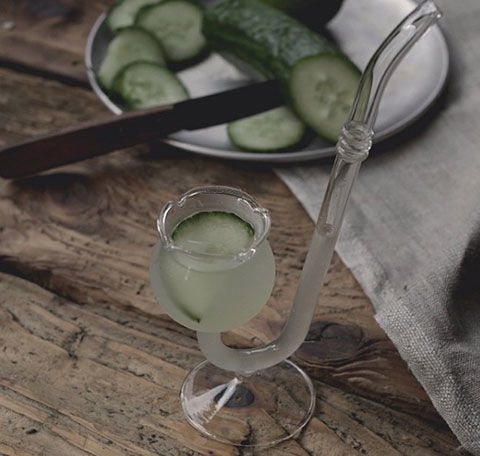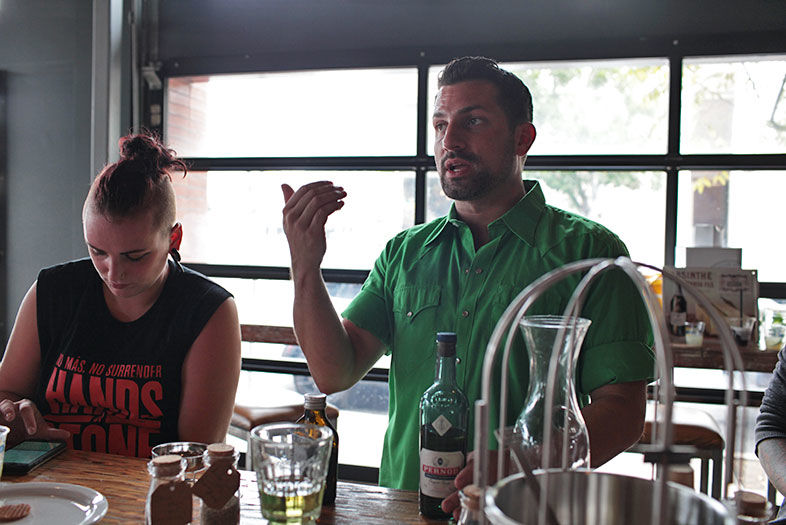Absinthe. So misunderstood. It’s not illegal, it won’t cause hallucinations, and just because a cocktail contains absinthe doesn’t mean you’ll be hit with a strong black-licorice flavor.
A couple of weeks ago, Joshua Lucas, the West Coast brand ambassador for Pernod Ricard (which makes Pernod Absinthe) let me sit in on one of his absinthe-education sessions for bartenders. Lucas talked about absinthe’s history, its role in cocktails, and how to tell a good absinthe from a bad one. Plus, he served everyone a Green Beast—a simple but delicious cocktail that was named Supreme Champion at the 2015 Drinks International Cocktail Challenge (see below for the recipe). Below, I’ve distilled Lucas’s lessons into a quick guide to absinthe.
Absinthe, no matter what brand or where it was produced, won’t result in hallucinations.
Absinthe’s initial purpose was medicinal—it was marketed in the 18th and 19th centuries as a cure-all elixir, used to treat malaria and dysentery, and kill bacteria. But it was also tasty—especially when served with some sugar and water—and intoxicating. It eventually became so popular among French bohemian society that wine producers felt threatened and reportedly started spreading rumors that absinthe was responsible for all sorts of socially unacceptable behavior (think 19th century Reefer Madness). A French psychiatrist named Valentin Magnan blamed this on wormwood, a key ingredient in absinthe, which contains a neurotoxin called thujone. Once absinthe is distilled, the amount of thujone is minuscule. Regardless, by the early 20th century, absinthe had been banned in several countries, including the U.S. and France. It’s only been in the last decade or so that the ban’s been lifted.
Any strange effects you might experience from absinthe isn’t because of the wormwood; it’s because it’s a really high-proof spirit. So, when you watch something like Buzzfeed’s “Americans Try Absinthe for the First Time,” know that they’re not tripping—they’re drunk.
Just because your drink includes absinthe doesn’t mean it’ll taste like black licorice.
Drink absinthe with a little sugar and water and the first taste that’ll hit you is anise, or black licorice. But that doesn’t mean cocktails with absinthe will taste like anise. It’s often used as a subtle aromatic—a glass will get an absinthe rinse before the cocktail’s added. It’s also used as a balancing agent to tone down the sweetness in cocktails—it’s why you’ll often see absinthe in rum drinks, especially tiki cocktails. Lucas recommends bartenders add three dashes of absinthe to Manhattans (whiskey, sweet vermouth, bitters). Absinthe mellows out the sweet vermouth, “and lets the whiskey shine through,” Lucas said.
No other spirit has cooler serving tools.
Absinthe balancier (here’s how it works)
How do you know which absinthe to buy?
You can’t go wrong with Pernod Absinthe Superieure—and I’m not saying that just because Lucas let me sit in on the absinthe class. It’s truly a great absinthe. So, too, is St. George’s Absinthe Vert, the first absinthe made in the U.S. after it became legal here in 2007. To determine a good absinthe from a lesser absinthe, Lucas recommended folks checkout The Wormwood Society’s absinthe reviews, which are extensive and detailed. Looking for something that leans minty? Floral? Traveling overseas and want to find an absinthe not available in the U.S.? They’ve got you covered. They also have reviews of absinthe’s close cousins, pastis and herbsaint.
Lucas is partial to absinthes distilled from grapes—it’s how absinthe was originally made. Cheaper absinthes are distilled from grain. A true absinthe shouldn’t contain any food coloring, either. The green comes from stinging nettle, one of the many herbs used to make absinthe.
Making a really good absinthe cocktail at home is easy.

6 Things You Didn’t Know about Absinthe
Pernod’s Green Beast cocktail served in an absinthe pipe. | Photo: Courtesy of Pernod Absinthe
The Green Beast
1 oz. Pernod Absinthe (or any other good brand)
1 oz. fresh lime juice
1 oz. simple syrup
4 oz. water
Thin cucumber slices
Pour all ingredients into a glass, add ice, stir and serve garnished with the cucumber slices.
Finding a great cocktail with absinthe in San Diego is easy, too.
The Sun-Beet
Where: Carnitas’ Snack Shack Embarcadero
What’s in it: White rum, lime, simple syrup, absinthe rinse
Nice Mangoes
Where: Sycamore Den
What’s in it: House rum blend, mango, fresh lime, falernum, allspice bitters, absinthe
The Final Countdown
Where: Bankers Hill Bar & Restaurant
What’s in it: Bols Genever, Spirit Works Sloe Gin, Campari, Carpano Bianco, peach bitters, absinthe
Like a Stone
Where: George’s at the Cove
What’s in it: House rum blend, fresh citrus, housemade stone-fruit butter, Pernod Absinthe
Ancient Astronaut
Where: Kindred
What’s in it: Dark spiced rum, aged rum, Jamaican rum, grapefruit, lime, cinnamon bark syrup, absinthe
Czech Yourself
Where: Bracero
What’s in it: Mezcal, Becherovka, falernum, lime, pineapple juice, orgeat, cinnamon syrup, absinthe
Lip Reader
Where: Craft & Commerce
What’s in it: Gin, Giffard Creme de Pamplemousse Rose, lemon, absinthe, champagne
Got suggestions for a future post? Write to [email protected].

6 Things You Didn’t Know about Absinthe
PARTNER CONTENT
Pernod ambassador Joshua Lucas talks absinthe at a recent bartender education session at URBN. | Photo: Kelly Davis

















